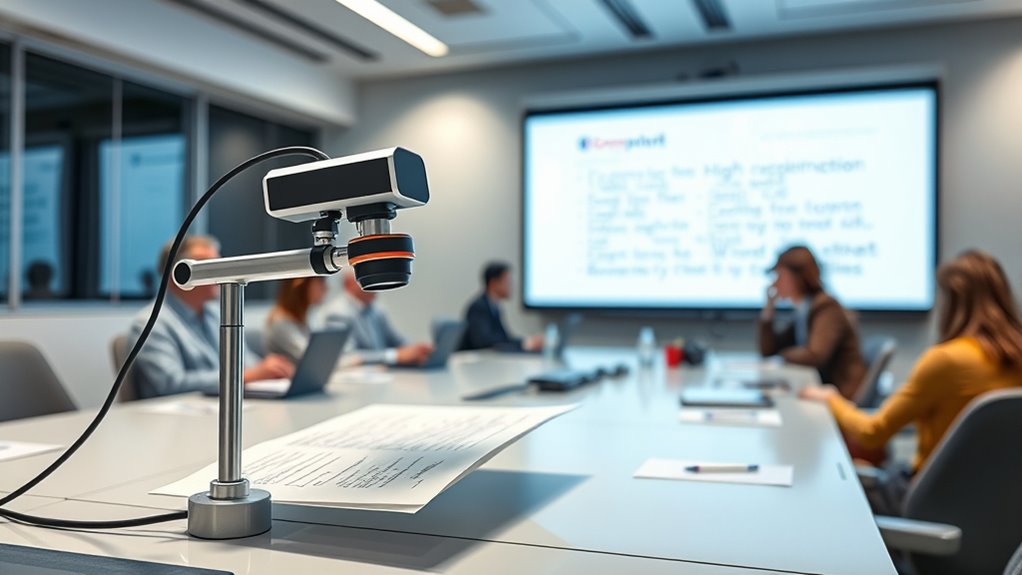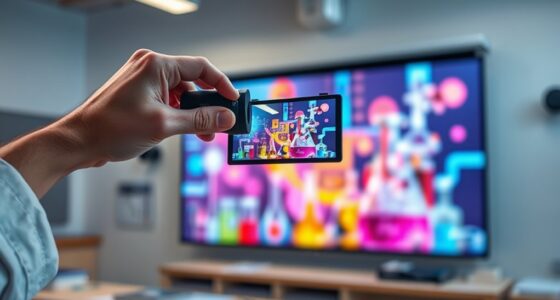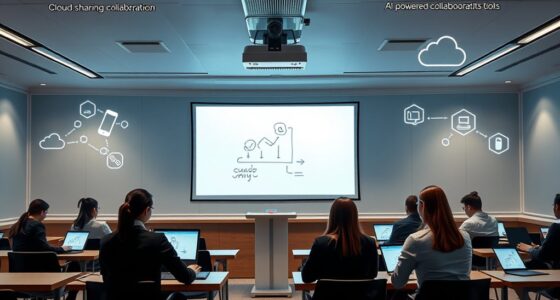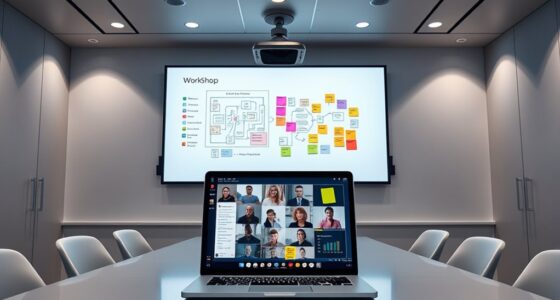Document cameras boost your remote presentations and training by providing crystal-clear, real-time visuals of physical items, notes, or artwork. They make it easy to highlight important details, switch between close-ups and wide views, and integrate with digital tools for an interactive experience. This helps your audience engage better and understand complex concepts more clearly. Keep exploring to discover how you can leverage these features for even more effective remote communication.
Key Takeaways
- Provide high-quality, real-time visual display of physical materials, ensuring clarity for remote viewers.
- Enable quick zoom, focus, and close-up shots to highlight critical details during presentations.
- Support live annotations and digital integration for interactive and engaging sessions.
- Allow recording of sessions for future reference, training, or sharing with remote audiences.
- Enhance remote communication by making visuals more vivid, precise, and impactful compared to static slides.
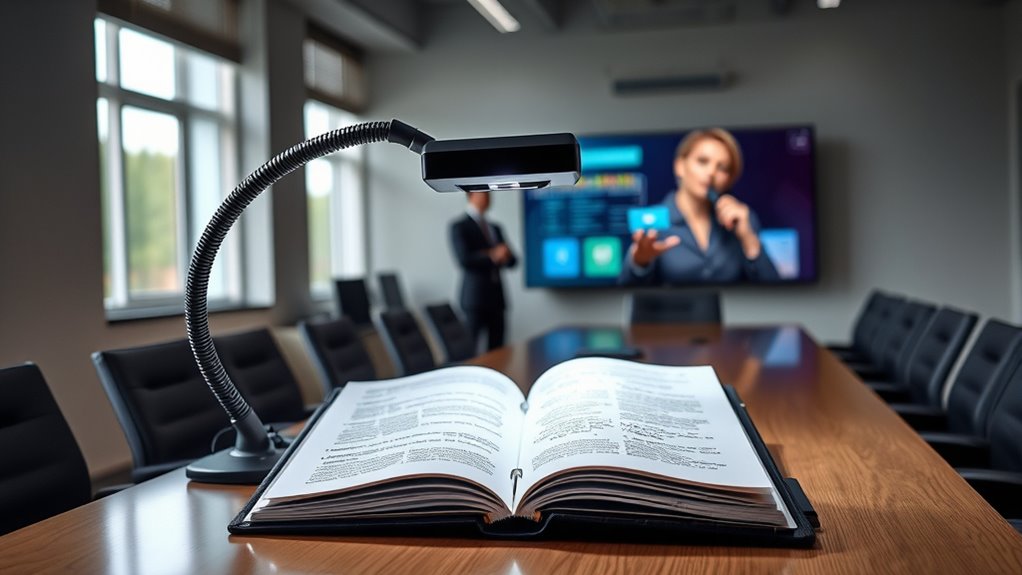
As remote presentations become increasingly common, document cameras have emerged as essential tools for enhancing visual clarity and engagement. When you’re trying to share detailed materials, whether it’s a handwritten note, a scientific specimen, or intricate artwork, a document camera provides a clear, real-time digital display that makes your visuals easily visible to your audience. Instead of relying on static slides or low-quality images, you can showcase physical objects with sharp detail, ensuring your viewers don’t miss important nuances. This ability to project physical materials directly onto their screens creates a more immersive and interactive experience, bridging the gap between in-person and remote communication.
The key advantage of using a document camera lies in its dynamic capabilities. With a simple setup, you can quickly switch from a broad overview to a close-up shot, highlighting specific details that are critical to your presentation or training. This instant adaptability keeps your audience engaged and allows for a more fluid, natural flow. Plus, many modern document cameras come equipped with digital displays that integrate seamlessly with your existing systems, making setup straightforward and reducing technical hurdles. These digital displays aren’t just for showing static images; they often support features like zoom, focus adjustments, and even annotations, giving you greater control over what your viewers see.
Interactive features further elevate the usefulness of document cameras. For instance, some models allow you to annotate directly on the live feed, emphasizing key points or drawing attention to particular areas. This interactivity encourages active participation from your audience, whether they’re in the same room or miles apart. Additionally, many document cameras can connect with other digital tools, such as interactive whiteboards or presentation software, enabling you to combine physical and digital content seamlessly. This integration transforms a simple visual aid into a versatile, engaging teaching or presentation platform.
Furthermore, the ability to record sessions using a document camera with interactive features means you can create valuable content for future reference. You can highlight complex concepts visually, clarify procedures with close-up shots, or demonstrate physical tasks step-by-step. Your audience benefits from these high-quality, detailed visuals, which can markedly improve understanding and retention. Utilizing digital display features aligns with the trend of increased resources and tools available for remote learning and presentations. Overall, by leveraging the digital display and interactive features of a document camera, you make your remote presentations more lively, precise, and impactful, ensuring your message resonates clearly regardless of where your audience is located.
Frequently Asked Questions
How Do Document Cameras Connect With Various Remote Conferencing Platforms?
You connect your document camera to remote conferencing platforms easily through wireless connectivity options like Wi-Fi or Bluetooth, guaranteeing a seamless experience. Most document cameras are compatible with popular platforms such as Zoom, Microsoft Teams, or Google Meet, allowing you to share live images instantly. Just ensure your camera’s firmware is up-to-date and check platform compatibility beforehand, so you can switch between devices smoothly during your presentation or training session.
What Are the Best Practices for Positioning a Document Camera During a Presentation?
To position your document camera effectively, focus on achieving ideal angles that clearly showcase your content without distortion. Use lighting techniques like adjusting ambient light or adding a desk lamp to minimize shadows and glare. Keep the camera steady and at eye level for natural viewing. Test the setup beforehand to ensure the image is sharp, well-lit, and easily visible, creating a professional and engaging presentation experience for your remote audience.
Can Document Cameras Be Used for Interactive Student Engagement Remotely?
Sure, you can use document cameras for interactive student engagement remotely—who knew? They boost student participation by allowing real-time feedback, making students feel like they’re right there in the classroom. With a simple setup, you can display student work, answer questions instantly, and foster lively discussions. It’s like having a magic window that turns a dull lecture into an engaging, participatory experience—minus the invisibility cloak.
What Are Common Technical Issues Faced When Using Document Cameras Online?
You might face technical issues like poor image quality or connectivity problems when using a document camera online. Sometimes, the camera’s resolution isn’t clear enough, making details hard to see, or a weak internet connection causes lag or disconnection. To avoid these issues, guarantee your camera settings are optimized for high quality, and use a stable, fast internet connection. Regularly updating drivers and software also helps keep everything running smoothly.
How Do Document Cameras Support Different Learning Styles in Remote Training?
Like a chameleon adapting to its environment, a document camera adjusts to support various learning styles. It caters to multisensory learning by combining visuals with real-time demonstrations, helping visual learners grasp concepts more effectively. You can display detailed images or text clearly, ensuring everyone stays engaged. This versatility makes remote training more inclusive, enabling you to reach visual learners and others, fostering a richer, more interactive learning experience.
Conclusion
Incorporating document cameras into your remote presentations transforms how you connect with your audience. They make your visuals clearer and your explanations more engaging, creating a seamless learning experience. Imagine the impact of your message when every detail is easily seen and understood—doesn’t that inspire greater confidence and trust? With this simple tool, you can elevate your training sessions and presentations, making them more effective and memorable. Are you ready to take your remote communication to the next level?
